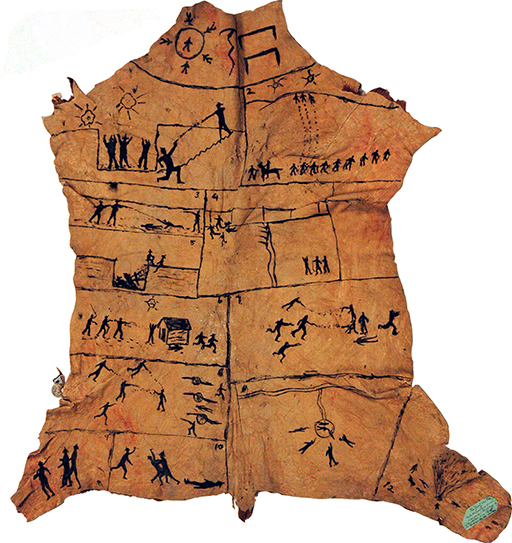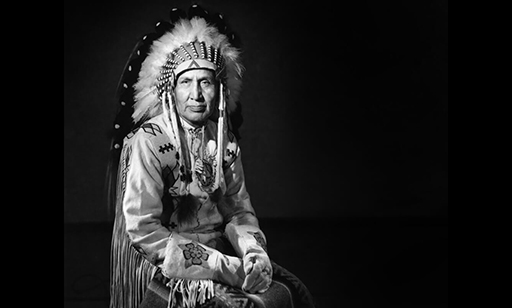1.5.2 Mike Mountain Horse
In this section, you will examine the experience of Mike Mountain Horse (1888–1964), one of the estimated 4,000 Canadian First Nations soldiers who fought in Europe. While First Nations people were at first prevented from joining the army, by December 1915 unofficial policies of exclusion came to an end and they were able to volunteer to join the army. In August 1917, conscription was introduced and participation of First Nations people in the war effort was now demanded.
Casualty figures are difficult to obtain and are often based on estimates because military records did not generally record race. We also do not have official numbers for honours awarded to Canadian First Nations soldiers, but Veterans Affairs Canada states that ‘at least fifty medals were awarded to aboriginal people in Canada for bravery and heroism.’ (Riseman and Winegard, 2015).
There is evidence to suggest that First Nations soldiers in the Canadian Army were not subject to the same humiliations that plagued African-American soldiers. One veteran, for example, remembered: ‘The army treated us all right … there was no discrimination “over there” and we were treated good.’ (Private Daniel Pelletier, cited in Riseman and Winegard, 2015.) After the war, however, Canadian First Nations people suffered the same inequality as they had prior to it. Nothing was gained by their sacrifice. For example, they did not receive the same pensions or disability and war veterans’ allowances as other veterans.
Mike Mountain Horse was from the Kainai (Blood) First Nation in southwestern Alberta, Canada. He enlisted in the army in 1916. In France, he first served with the 191st Battalion and was later in the machine gun section of the 50th Battalion. He took part in several battles, including Vimy Ridge, Cambrai and Amiens, and he was wounded three times. At Cambrai he witnessed ‘the first massed tank attack in history, and was buried under the ruins of a shelter for four days after it was covered by rubble thrown up by explosions’ (Olusoga, 2014, p.12). He returned home to his Reserve in 1919 having been awarded a Distinguished Conduct Medal.
Did you know?
Mountain Horse’s service records have been digitised and can be found on this Imperial War Museum website [Tip: hold Ctrl and click a link to open it in a new tab. (Hide tip)] .
His autobiography, which he dictated to Ambrose Two Chiefs, gives a sense of his battlefield experience. Here is a short excerpt:
Lying on top of Vimy Ridge one night along with a number of the other Indian boys, the scene before our eyes might best be described as that of a huge stage with lighting effects – Verey lights from the Hun lines, and flames from bursting shells in the city of Lens. The red glare thrown back appeared like a great fire in the sky all the time. The trenches ran through almost to the heart of the French coal mining city. Here a Brigade of the Germans had entrenched themselves so well that incessant bombardment by artillery and bombing from the air did not aid the boys from the Dominion to any great extent … Along the miles of trenches one could see planes dropping bombs on German lines, followed by geysers of smoke and dirt shooting skywards like volcanoes in eruption. One could witness houses bursting suddenly into flame as projectiles from heavy artillery of the enemy struck them. One could walk past Canadian howitzer batteries about a mile from the trenches and hear the 57inch shells from these guns screaming overhead on their errands of death and destruction.

Figure 13 shows a story robe on calf skin, produced by the artist Ambrose Two Chiefs, possibly in the 1930s. The artist used this traditional way to illustrate his friend Mountain Horse’s war experiences on the Western Front. The events are depicted in order of the importance to Mountain Horse, including the four days he spent buried in a bomb shelter (Olusoga, 2014, pp.12-13).
Activity 4 ‘Story Robe’ by Ambrose Two Chiefs
Take a moment to study the story robe closely. What experiences did the artist depict? This might also be a good activity for students to complete.
Comment
Ambrose Two Chiefs painted figures fighting with guns, the German soldiers clearly recognisable by their Pickelhaube helmets. He depicted detonating shells, bullets flying through the air and explosions. We can make out trenches, depictions of hand-to-hand combat, and soldiers surrendering – a host of details of fighting on the Western Front. One panel shows an attack in which the Canadians captured German artillery.
Some indigenous Canadian troops observed their traditional warrior traditions on the Western Front. David Olusoga describes how a member of the Blood tribe named George Strangling Wolf prepared for battle in November 1917.
[He] took a knife and cut off a strip of his own flesh from around his knee. Holding up the bloody offering towards the sun, he prayed aloud: “Help me, Sun, to survive this terrible war, that I may meet my relatives again. With this request, I offer you my body as food.” He then buried his flesh in the mud of northern France. Strangling Wolf, whose official army records list his religion as “Church of England”, survived the war under the gaze of the Sun Spirit of his ancestors.
This quote shows the juxtaposition of fighting a modern war in Europe with deadly weapons designed to inflict maximum casualties while bringing to bear ancient rituals, which, if anything, made Strangling Wolf more likely to die given the risk of infection such a self-inflicted wound carried. But it also highlights that army records do not always tell the truth about the people they recorded. We can only speculate here whether there were only limited options of what to record in the record or whether Mountain Horse perhaps considered himself to belong to the Church of England alongside holding his ancestral beliefs.
Did you know?
Resources and further reading
Mountain Horse dictated his reminiscences of the war years to Ambrose Two Chiefs. In them, he recalls when Britain declared war on Germany. Students could analyse this source and discuss the usefulness of it to historians. It might be worth discussing, for instance, why Mountain Horse dictated his memories and what his motivation may have been. Mountain Horse (1979)is available digitised with free downloads at Internet Archive.
Riseman and Winegard (2015) provide a useful overview of the indigenous experience of the British Dominions.
Monographs on Canadians in the First World War include Cook (2007) and Winegard (2012)
There is some information on Mountain Horse on the Valour Canada website.
This short videotells the story of Mountain Horse and his contribution to the war.

